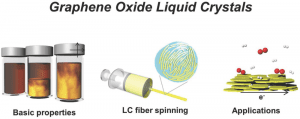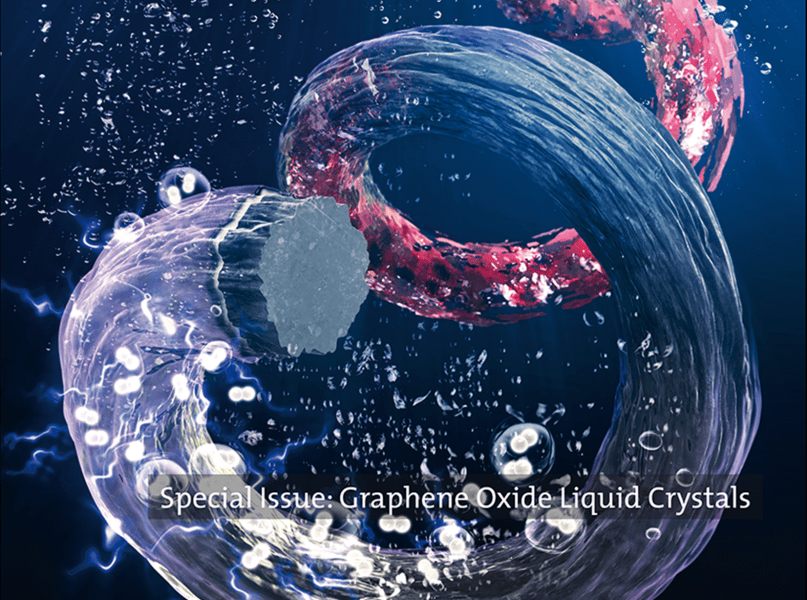By Kyung Eun Lee and Sang Ouk Kim
Since our first discovery of Graphene oxide liquid crystals (GOLCs) in 2010, the relevant research field has rapidly grown in the aspects of fundamental science as well as application research. Graphene oxide (GO) is a typical chemically modified graphene with oxygenated form, possessing a discotic colloidal shape with large shape anisotropy. Unlike the chemically inert pristine counterpart, GO is known to be able to form a thermodynamically stable monolayer exfoliated dispersion in water, and exhibit colloidal liquid crystalline properties with long-range alignment above a noticeably low concentration of approximately 0.1 wt%. The resultant aqueous GOLC is a promising material as a typical building block of anisotropic 2D colloid particles, especially as a key building block for diverse graphene-assembled structures, while controlling its molecular scale orderings. The great potential of GOLC has already been demonstrated in many application fields, such as energy storage/conversion, optoelectronics, catalysis, graphene fiber spinning, and textiles over the past several years, and more innovative utilization is anticipated in the near future.
As this graphene-based novel liquid crystalline material is becoming a major scientific and technological issue in the field of materials science and nanotechnology, we have compiled a special issue on the subject of “Graphene Oxide Liquid Crystals”. In this issue, we have collected contributions from world-renowned researchers, who laid the foundation for long-term research in a wide range of related fields from basic fundamental properties of GOLCs to their versatile applications. We believe that it is timely for us to publish this special issue on GOLC, and think it will be of great interest to many researchers and general readers of Particles & Particle Systems Characterization.

A selection of the topics covered in this special issue about GOLCs: investigation of their properties, further processing by fiber, and applications.
In this special issue, several contributions focus on the scientific understanding of GOLC systems by controlling physical/chemical properties of GO. In a progress report, S. Seyedin and J. M. Razal et al. summarize recent advances in the synthesis mechanism, processing, composites and applications of GOLC (https://doi.org/10.1002/ppsc.201600396). In a review paper, S. Kumar et al. describe the research status on the supramolecular assembly of discotic liquid crystal complexes and the perspectives for related fields (https://doi.org/10.1002/ppsc.201700003). The control of chemical composition of GO may also influence the molecular level interactions of GOLC and the relevant research results are presented in several communications and full papers. S. J. Yang and C. R. Park et al. address the effect from the degree of functionality on the LC characteristics of GO dispersion (https://doi.org/10.1002/ppsc.201600383). M. Majumder et al. report how the pH change of GO dispersion influences the secondary interaction of GO particles, and they also introduce a fundamental system to analyze the fine structure of GOLC (https://doi.org/10.1002/ppsc.201600391). J.-K. Song et al. find that they can artificially control GOLC characteristics more precisely than possible by the gravity-induced phase separation method (https://doi.org/10.1002/ppsc.201600344). They prove that dielectrophoresis can be a powerful tool to induce liquid crystalline phase separation of GO.
Several contributions have also been made in the field of graphene based liquid crystalline fiber spinning, one of GOLC’s most popular research areas. T. H. Han et al. report a novel method for GOLC fibers with improved strength and stiffness while using trivalent metal ions as coagulant (https://doi.org/10.1002/ppsc.201600401). H. S. Shin et al. are able to fabricate high-strength GO-PVA composite fibers by increasing the interfacial adhesion between dopamine-coated GO and PVA (https://doi.org/10.1002/ppsc.201600382). A piezoresistive sensing test is presented for potential use in a wearable strain gauge.
The applications of GOLC in catalysts are discussed in the following papers. Our research group reports a facile fabrication of electrocatalytically active molybdenum sulfide/graphene composite fibers (https://doi.org/10.1002/ppsc.201600375). The synergistic effect from electro-conductive GOLC based fibers and catalytic active amorphous molybdenum sulfide allows for stable electrocatalytic activities. K. Konstantinov et al. produce 3D structures consisting of Co/Co3O4 using the liquid crystalline property of GO, and analyze the catalytic activities for hydrogen and oxygen evolution in alkaline media (https://doi.org/10.1002/ppsc.201600386). J.–B. Baek et al. produce iodinated kish graphite by ball-milling and show an improved electrocatalytic activity in the oxygen reduction reaction as well as better stability and resistance to impurities (https://doi.org/10.1002/ppsc.201600426). Besides, K. J. Lee et al. demonstrate a novel effective approach for ultrafast graphene growth by Xenon flash lamp irradiation (https://doi.org/10.1002/ppsc.201600429) and the group of L. Dai introduces a reliable layer-by-layer transfer of CNT/Graphene hybrid structures for supercapacitor application (https://doi.org/10.1002/ppsc.201700131).
Recently, the technological significance of graphene based materials is rapidly increasing with the close advent of the 45th industrial revolution, where lightweight, biocompatible, and flexible portability is highlighted in many wearable or implantable devices. It is noteworthy that GOLC is one of the most promising materials for high-performance, carbon-based materials and devices, along with its unprecedented advantage in the precise control of molecular orientation relying on a low-cost facile solution process. Nonetheless, research on GOLC is still in the early stages yet, particularly considering the real-world practical application of high-performance, carbon-based materials. In the near future, more research attention is required while combining multidisciplinary knowledge from various scientific fields such as physics, chemistry, biology, and engineering. In this special issue, we sought to construct a collection of interesting topics on the promising research field of GOLC. We would like to thank all the world-renowned scholars for their contribution and Wiley-VCH editorial team, including Mary De Vita, for the strong support. Finally, we hope that many readers from different disciplines will encounter this special issue and attain a basic understanding of this emerging material and foster an opportunity to explore interesting research topics.

















